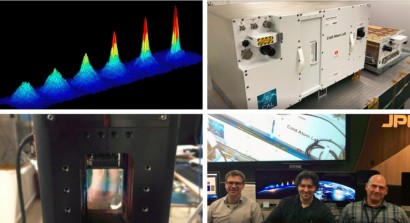The International Space Station is officially home to the coolest experiment in space, where NASA’s Cold Atom Laboratory (CAL), designed and built here in Pasadena at Jet Propulsion Laboratory, was installed in the station’s U.S. science lab in late May and is now chilling in orbit.
Inside the space station, CAL is now producing clouds of ultracold atoms known as Bose-Einstein condensates (BECs). These BECs reach temperatures just above absolute zero, the point at which atoms should theoretically stop moving entirely. This is the first time BECs have ever been produced in orbit.
“Having a BEC experiment operating on the space station is a dream come true,” said Robert Thompson, CAL project scientist and a physicist at JPL. “It’s been a long, hard road to get here, but completely worth the struggle, because there’s so much we’re going to be able to do with this facility.”
CAL scientists confirmed last week that the facility has produced BECs from atoms of rubidium, with temperatures as low as 100 nanoKelvin, or one ten-millionth of one Kelvin above absolute zero, or zero Kelvin, which is equal to minus 459 degrees Fahrenheit. That’s colder than the average temperature of space, which is about 3 Kelvin, or minus 454 degrees Fahrenheit.
 NASA said CAL scientists have their sights set even lower, and expect to reach temperatures colder than what any BEC experiments have achieved on Earth.
NASA said CAL scientists have their sights set even lower, and expect to reach temperatures colder than what any BEC experiments have achieved on Earth.
Although the phenomenon of BECS was first predicted 71 years earlier by physicists Satyendra Nath Bose and Albert Einstein, the first laboratory BECs were produced only in 1995. Eric Cornell, Carl Wienman and Wolfgang Ketterle shared the 2001 Nobel Prize in Physics for being the first to create and characterize BECs in the lab.
Hundreds of BEC experiments have been operated on Earth since the mid-1990s, and a few BEC experiments have even made brief trips to space aboard sounding rockets. But CAL is the first facility of its kind on the space station, where scientists can conduct daily studies of BECs over long periods.
During its first year on the space station, five science groups, including groups led by Cornell and Ketterle, will conduct experiments with CAL.
“CAL is an extremely complicated instrument,” said Robert Shotwell, chief engineer of JPL’s astronomy and physics directorate, who has overseen the challenging project since February 2017. “Typically, BEC experiments involve enough equipment to fill a room and require near-constant monitoring by scientists, whereas CAL is about the size of a small refrigerator and can be operated remotely from Earth. It was a struggle and required significant effort to overcome all the hurdles necessary to produce the sophisticated facility that’s operating on the space station today.”
In addition to the BECs made from rubidium atoms, the CAL team is working toward making BECs using two different isotopes of potassium atoms.
CAL is currently in a commissioning phase, in which the operations team conducts a long series of tests to fully understand how the CAL facility operates in microgravity.
“There is a globe-spanning team of scientists ready and excited to use this facility,” said Kamal Oudrhiri, JPL mission manager for CAL. “The diverse range of experiments they plan to perform means there are many techniques for manipulating and cooling the atoms that we need to adapt for microgravity, before we turn the instrument over to the principal investigators to begin science operations.” The science phase is expected to begin in early September and will last three years.
The Cold Atom Laboratory launched to the space station on May 21 aboard a Northrop Grumman (formerly Orbital ATK) Cygnus spacecraft from NASA’s Wallops Flight Facility in Virginia. Designed and built at JPL, CAL is sponsored by the International Space Station Program at NASA’s Johnson Space Center in Houston, and the Space Life and Physical Sciences Research and Applications (SLPSRA) Division of NASA’s Human Exploration and Operations Mission Directorate at NASA Headquarters in Washington.
For more information about the Cold Atom Lab, visit www.coldatomlab.jpl.nasa.gov.

















